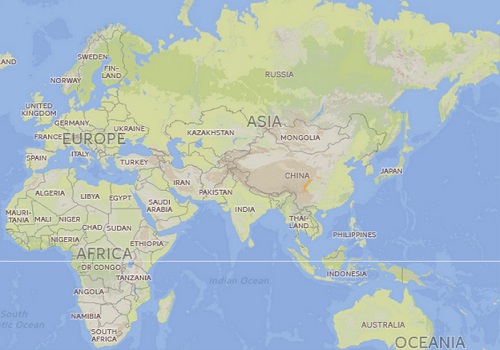Taxonomy

The giant panda is listed as an endangered species by the IUCN Red List of Threatened Species
- Kingdom: Animalia
- Phylum: Chordata
- Class: Mammalia
- Order: Carnivora
- Family: Ursidae
- Genus: Ailuropoda
- Species:
o
o
Name
- Common name: Giant panda, panda bear, panda.
- Scientific Name: Ailuropoda melanoleuca
Distribution and Habitat
- Historically the giant panda occupied most of southern and eastern China. Today its distribution has been reduced by 92% from its original range.
- Currently they are found in south central China in 6 mountain ranges in the provinces of Sichuan, Gansu and Shaanxi. About 75% of its population inhabits in Sichuan Province.
- Giant pandas inhabit temperate forest and subalpine habitats at elevations of 4,000 to 11,500 ft or 1,200 to 3,500 meters. In summer they ascent to higher elevations and in winter to lower elevations.
- Old growth forests with many species of bamboo and access to water is their preferred habitat.

Giant Panda Distribution Map. Source: IUCN Red List of Threatened Species
Physical Features
- Giant pandas have shorter legs and larger heads than most bears.
- These bears have poor vision and an acute and sophisticated sense of smell.
- Its coat is white with black eye patches, ears, legs and across the shoulders.
- Fur is short and thick providing insulation against cold temperature and snow.
Weight and Height
- Males are about 20% larger than females.
- The length of panda bears is from 5.3 to 6.2 ft or 1.6 to 1.9 m.
- They weigh from 187 to 276 lb or 85 to 125 kg.
- Its tail is from 4 to 6 in or 10 to 15 cm.
Behavior
- They are active at any time of day and night with peak periods at dusk and dawn.
- Its activity level varies with weather.
- They are solitary animals unless it is breeding season or females are raising cubs.
- Giant pandas do not hibernate because food is available year round.
- Because bamboo is poor in nutrients pandas cannot gain enough fat deposits to hibernate.
- Pandas descent to lower elevations for winter and return to higher elevations for summer.
- Their home range is from 5 to 18 sq km but inhabit only 10% of it on a regular basis. Males have larger home ranges than females.
- Male home ranges overlap extensively but one male is the dominant one. Females ranges do not overlap.
- Giant pandas mark their territories with scent gland secretions and urine on trees and rocks.
Diet
- Although it belongs from the order carnivora, more than 99% of its diet is bamboo. They consume 23 to 36 lbs or 12 to 15 kg of bamboo roots and leaves every day. They can eat up to 84 lbs or 38 kg of new bamboo shoots.
- 35 species of bamboo are eaten by pandas in the wild.
- 1% of its diet consists of eat eggs, carrion or small animals.
- They spend more than 14 hours a day feeding.
Reproduction
- Males and females reach reproductive maturity at 6 years old. Females can reproduce until they are 20 while males until 26 years old.
- Giant pandas are polygynous, they mate with multiple partners.
- Females may breed every 2 years or more.
- Reproduction occurs from March to May and it is influenced by food supply available to the mother.
- Gestation lasts from 84 to 184 days including delayed implantation. The egg is fertilized but the implantation is delayed.
- The mother prepares a birthing nest in rock crevices, hollow trees or under fallen logs.
- They give birth usually between August to October.
- Litter size is 1 to 2 but only one cub is raised in the wild.
The young
- Cubs are born pink and naked with very little white hair covering their bodies. They weigh 3 to 5 oz or 85 to 140 grams.
- At 8 to 10 days its skin turns grey in areas where fur will be black.
- They begin to eat bamboo at around 5 months.
- Cubs stay with their mother until they are up to 18 months old.
Baby pandas from newborn to three months. Source: Treehugger
Life Expectancy
- Giant pandas can live up to 20 years in the wild and 30 years in captivity.
Threats
- Fragmentation, degradation and loss of habitat due to agriculture, livestock and industrial development.
- Low genetic variability due to inbreeding within smaller subpopulations.
- Dependence on bamboo as a primary food source. Bamboo regenerates every 5 years to be edible by pandas.
Conservation Status
- According to the IUCN Red List of Threatened Species there were fewer than 2,500 pandas in the wild and its population shows a declining trend.
- The status of the giant panda in the IUCN Red List is “Endangered”.
- In China they are given maximum protection and are listed under Category 1 of the Chinese Wildlife Conservation Law.
- They are listed on Appendix 1 of CITES.
Did you know?
- Giant pandas are the only bears that do not hum.
Related Species
 |
 |
 |
 |
| Bear, Andean or Spectacled |
Bear, Asiatic Black |
Bear, Black | Bear, Brown |
 |
 |
 |
 |
| Bear, Giant Panda | Bear, Polar | Bear, Sloth | Bear, Sun |
References and further research
IUCN Red List of Threatened Species – Ailuropoda melanoleuca
University of Michigan Museum of Zoology – Ailuropoda melanoleuca giant panda
World Association of Zoos and Aquariums WAZA _ Giant Panda (Ailuropoda melanoleuca)
San Diego Zoo Library – Giant Panda, Ailuropoda melanoleuca
ITIS Report – Ailuropoda melanoleuca




